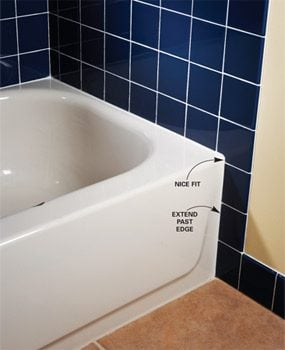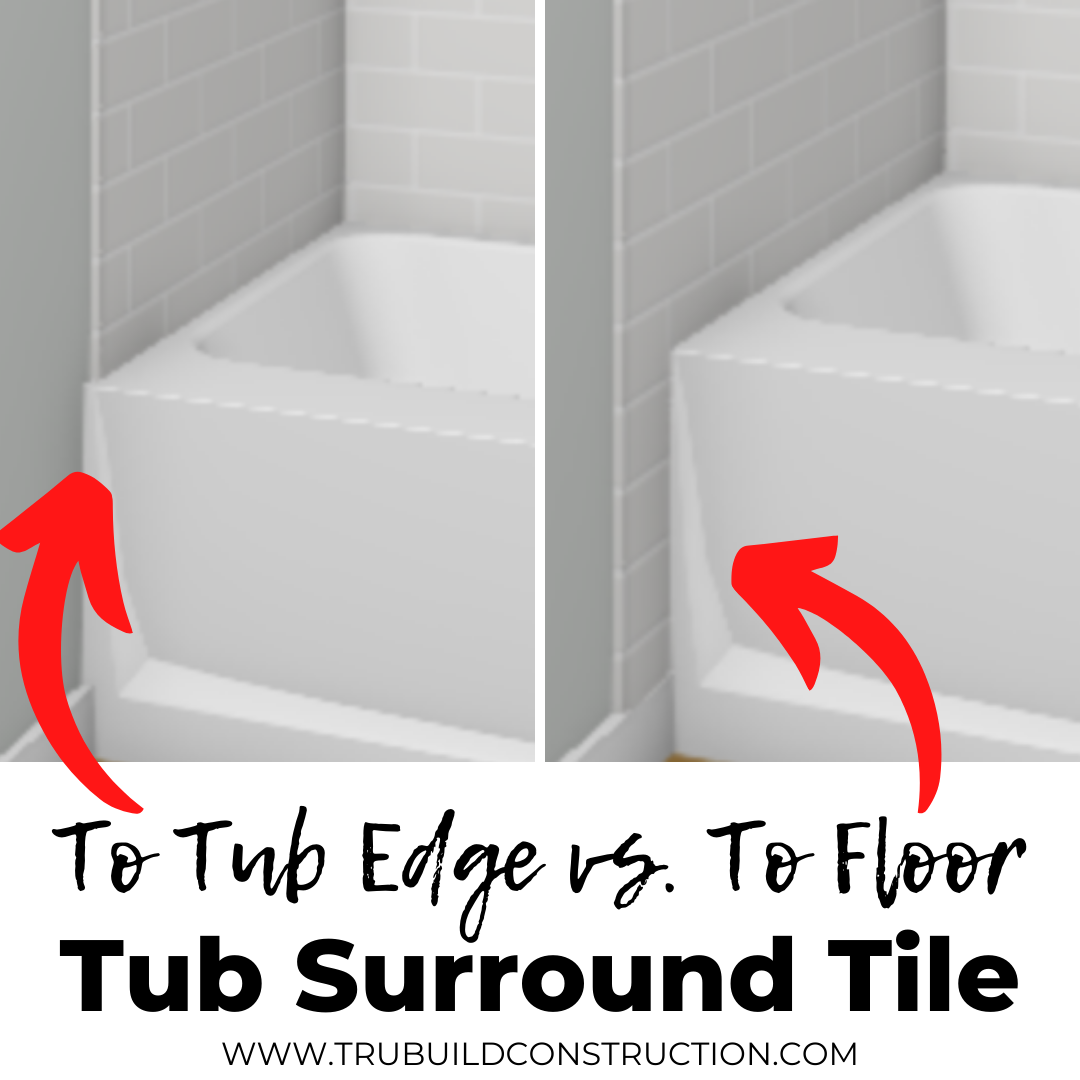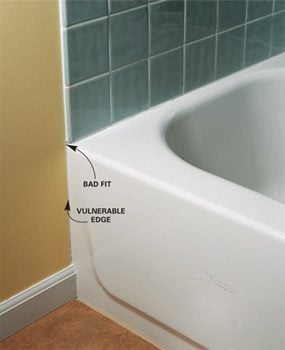Preparing the Surface: Essential Steps Before Installation
Before embarking on the installation of bathroom tile around a tub, proper surface preparation is crucial for ensuring a successful and long-lasting result. Here are the essential steps to take:
-
Clean the Surface: Begin by thoroughly cleaning the area around the tub to remove any dirt, grime, or residue. Use a suitable cleaner and scrubbing brush to ensure the surface is free from any contaminants that could interfere with tile adhesion.
-
Inspect for Damage: Check the walls surrounding the tub for any signs of damage, such as cracks, water damage, or mold. Address any issues promptly, as installing tile over damaged surfaces can lead to future problems and compromise the integrity of the installation.
-
Repair and Prepare: Repair any damage to the walls and ensure they are smooth, level, and structurally sound. Fill in any cracks or holes with a suitable patching compound and sand down rough or uneven areas to create a flat, uniform surface for tile installation.
-
Apply a Waterproofing Membrane: To protect the underlying structure from water damage, apply a waterproofing membrane to the walls surrounding the tub. This step is especially important in wet areas like bathrooms to prevent moisture penetration and potential mold growth.
-
Allow for Drying Time: Once the waterproofing membrane is applied, allow sufficient time for it to dry completely before proceeding with tile installation. Follow the manufacturer’s instructions regarding drying times to ensure optimal performance and durability.
-
Prime the Surface: Before tiling, prime the walls with a suitable primer to promote better adhesion and ensure a strong bond between the tile and the substrate. Use a primer specifically designed for use with tile installations and follow the manufacturer’s recommendations for application.

Choosing the Right Tile: Factors to Consider
Selecting the appropriate tile for your bathroom can significantly impact the aesthetics, durability, and overall success of your project. Here are some key factors to consider when choosing the right tile for installing around a tub:
Material: Bathroom tiles come in various materials, each with its unique characteristics and advantages. Common options include ceramic, porcelain, glass, natural stone, and mosaic tiles. Consider factors such as durability, water resistance, maintenance requirements, and aesthetic appeal when choosing the material.
Size and Shape: Tiles are available in a wide range of sizes and shapes, from small mosaic tiles to large-format tiles. Consider the size of the space, the layout of the tub surround, and your design preferences when selecting tile size and shape. Larger tiles can create a more streamlined look with fewer grout lines, while smaller tiles offer more intricate design possibilities.
Color and Finish: Choose tile colors and finishes that complement your bathroom decor and personal style. Lighter colors can make small bathrooms feel more spacious and airy, while darker colors add depth and drama. Consider the overall color scheme of the bathroom and select tiles that harmonize with existing fixtures and finishes.
Texture: Pay attention to the texture of the tile surface, especially in wet areas like tub surrounds. Textured tiles provide better traction and slip resistance, reducing the risk of accidents in the bathroom. Matte or honed finishes are generally less slippery than glossy finishes and are ideal for floor tiles or areas prone to moisture.
Maintenance: Consider the maintenance requirements of different tile materials and finishes. Some tiles may require regular sealing or special cleaning products to maintain their appearance and durability. Choose tiles that fit your lifestyle and maintenance preferences to ensure long-term satisfaction with your bathroom investment.
Budget: Finally, consider your budget when selecting bathroom tiles. Prices can vary widely depending on the material, size, brand, and quality of the tile. Determine your budget constraints upfront and explore options that offer the best value for your investment without compromising on quality or aesthetics.
Planning the Layout: Ensuring Proper Alignment and Symmetry
Proper planning and layout are essential for achieving a visually pleasing and professionally finished tile installation around a tub. Here are the key steps to ensure proper alignment and symmetry:
Measure the Area: Begin by measuring the walls surrounding the tub to determine the total surface area to be tiled. Take accurate measurements of both the length and height of each wall, as well as any recessed areas or obstacles that may affect the layout.
Establish a Starting Point: Decide on a starting point for the tile installation, typically the center of the back wall or the edge of the tub. This will serve as a reference point for laying out the tile pattern and ensuring proper alignment and symmetry.
Dry Lay Tiles: Before applying adhesive, dry lay the tiles in the desired pattern to visualize the layout and make any necessary adjustments. Use tile spacers to ensure even spacing between tiles and maintain straight grout lines.
Plan Tile Cuts: Determine where tile cuts will be necessary to fit around fixtures, corners, or edges. Minimize the number of cuts and ensure they are strategically placed to maintain symmetry and balance in the tile layout.
Consider Tile Orientation: Experiment with different tile orientations, such as horizontal, vertical, or diagonal, to achieve the desired visual effect. Consider the size and shape of the tiles, as well as the overall design aesthetic, when selecting the orientation.
Check for Level and Plumb: Use a level and a plumb line to ensure that the tiles are installed straight and level. Make any necessary adjustments to ensure uniformity and symmetry throughout the installation process.
Installing the Tile: Techniques for a Professional Finish
Proper installation techniques are essential for achieving a professional-looking finish and ensuring the long-term durability of your tile installation around a tub. Here are some key techniques to follow:
Mix and Apply Thinset: Prepare thinset mortar according to the manufacturer’s instructions, ensuring proper consistency and thorough mixing. Apply a generous amount of thinset to the back of each tile using a notched trowel, ensuring full coverage for maximum adhesion.
Set the Tiles: Press each tile firmly into place, using spacers to maintain even spacing between tiles and ensure straight grout lines. Work in small sections, starting from the established starting point and working outward to prevent the thinset from drying out prematurely.
Check for Level and Alignment: Use a level and a straightedge to check for level and alignment as you work. Make any necessary adjustments to ensure that the tiles are installed straight, level, and in line with the established layout.
Cut Tiles as Needed: Use a tile cutter or wet saw to cut tiles to fit around fixtures, corners, or edges. Measure carefully and mark the tiles before cutting to ensure accurate cuts and minimize waste.
Allow for Expansion Joints: Leave expansion joints around the perimeter of the tiled area and at regular intervals to allow for movement and prevent cracking. Fill these joints with flexible caulk or grout after the tile installation is complete.
Remove Excess Thinset: Clean up any excess thinset from the tile surfaces and grout lines before it dries. Use a damp sponge or cloth to wipe away excess mortar, ensuring a clean and uniform finish.
Grouting and Sealing: Final Steps for Durability and Aesthetics
Grouting and sealing are the final steps in the tile installation process, essential for enhancing durability, protecting against moisture damage, and ensuring a polished finish. Here’s how to complete these final steps effectively:
Select the Right Grout: Choose a grout color that complements your tile and desired aesthetic. Consider factors such as color, texture, and stain resistance when selecting grout. Opt for sanded or unsanded grout depending on the width of the grout lines.
Mix Grout: Mix the grout according to the manufacturer’s instructions, ensuring a smooth, lump-free consistency. Allow the grout to rest for a few minutes before applying to allow any air bubbles to escape.
Apply Grout: Use a grout float to apply the grout evenly over the tiled surface, working it into the joints at a 45-degree angle. Work in small sections and remove excess grout from the tile surface using a damp sponge or cloth.
Tool Joints: After applying the grout, use a grout tool or rounded stick to tool the joints and remove any excess grout. This helps create smooth, uniform grout lines and ensures proper adhesion.
Allow to Cure: Allow the grout to cure for the recommended time specified by the manufacturer before sealing. Avoid walking on or disturbing the tiled area during this time to prevent damage to the freshly applied grout.
Apply Sealer: Once the grout is fully cured, apply a penetrating grout sealer to protect against moisture penetration, staining, and mold growth. Use a brush or roller to apply the sealer evenly over the grout lines, taking care not to allow the sealer to come into contact with the tile surface.
Common Mistakes to Avoid
While installing bathroom tile around a tub, several common mistakes can compromise the quality and longevity of the project. Here are some pitfalls to avoid:
-
Insufficient Surface Preparation: Skipping or rushing through surface preparation can lead to poor tile adhesion, uneven surfaces, and premature failure of the installation. Take the time to clean, repair, and prime the surface properly before tiling.
-
Poor Tile Layout Planning: Failing to plan the tile layout meticulously can result in awkward cuts, misalignment, and an unprofessional finish. Invest time in dry laying tiles, planning cuts, and establishing a starting point to ensure proper alignment and symmetry.
-
Using Incorrect Materials: Using the wrong type of tile, adhesive, grout, or sealer can lead to compatibility issues, adhesion failures, and unsightly results. Always use materials specifically designed for use in wet areas like bathrooms and follow manufacturer recommendations.
-
Ignoring Expansion Joints: Neglecting to leave expansion joints around the perimeter of the tiled area and at regular intervals can result in cracked tiles and grout lines due to movement. Incorporate expansion joints into the tile layout and fill them with flexible caulk or grout after installation.
-
Improper Grout Application: Applying grout incorrectly, such as using too much water or failing to remove excess grout promptly, can lead to weak joints, staining, and uneven grout lines. Follow proper grouting techniques and tools to achieve a clean and uniform finish.
-
Skipping Sealing: Failing to seal grout leaves it vulnerable to stains, moisture penetration, and mold growth, compromising the appearance and durability of the installation. Always seal the grout after it has fully cured to protect against damage and maintain its integrity over time.
How long does it take to install bathroom tile around a tub?
The time required for tile installation depends on various factors, including the size of the area, the complexity of the layout, and the experience of the installer. On average, it may take several days to complete the installation, including surface preparation, tile setting, grouting, and sealing.
What type of tile is best for use around a tub?
Ceramic, porcelain, and natural stone tiles are popular choices for use around tubs due to their durability, water resistance, and aesthetic appeal. Porcelain tiles, in particular, are highly durable and low-maintenance, making them suitable for wet environments like bathrooms.
Do I need to waterproof the walls before installing tile around a tub?
Yes, it is essential to waterproof the walls surrounding the tub to protect the underlying structure from water damage. Apply a waterproofing membrane or sealant to create a barrier against moisture penetration and prevent potential issues such as mold growth and structural damage.
Can I install tile over existing tile around a tub?
In some cases, it may be possible to install new tile over existing tile, provided that the existing surface is in good condition and properly prepared. However, this approach may add thickness to the walls and may not be suitable for all situations. It is best to consult with a professional to determine the feasibility and best course of action.
How do I clean and maintain bathroom tile around a tub?
Regular cleaning and maintenance are essential for preserving the appearance and longevity of bathroom tile. Use a mild detergent or tile cleaner and a soft brush or sponge to clean the tile surface regularly. Avoid harsh abrasives or acidic cleaners that can damage the tile or grout. Additionally, seal grout periodically to protect against stains and moisture damage.
What should I do if I encounter mold or mildew around the tub tile?
If mold or mildew develops on the tile or grout, use a mildew remover or a mixture of bleach and water to clean the affected areas thoroughly. Scrub the surface with a brush or sponge, rinse with clean water, and allow the area to dry completely. Take steps to improve ventilation and reduce moisture in the bathroom to prevent mold growth in the future.
Part “1” HOW TO TILE 60″ tub surround walls – preparation, where to start tiling, tile layout
Creative Bathtub Tile Ideas And Inspiration u2014 TruBuild Construction
Tile Layout for Tubs and Showers (DIY) Family Handyman
How to Tile Your Tub Surround
How to Tile a Shower/Tub Surround, Part 1: Laying the Tile
Bath Tiles
Related Posts:











